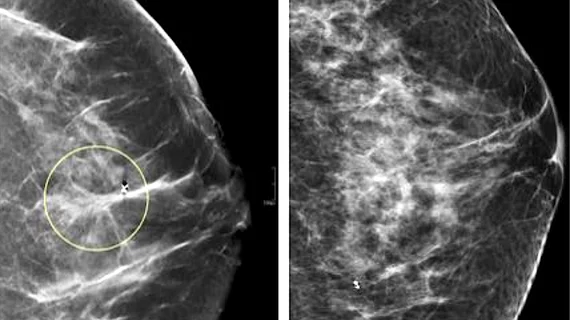Digital breast tomosynthesis might be the preferable cancer screening method for women with dense breasts who also have other risk factors, as new research suggests it decreases the likelihood that advanced breast cancer will go undetected.
A new paper published this week in JAMA shares how researchers analyzed more than 1 million screening mammograms to compare invasive interval cancer detection rates to advanced cancer detection rates for both digital breast tomosynthesis and digital mammography exams—with special attention paid to women with dense breasts and other factors that raise their risk of a breast cancer diagnosis. Though there were no statistically significant differences between interval cancer rates for DBT and DM screening methods on women at average risk, women with extremely dense breasts and additional risk factors were found to have increased rates of advanced cancer detection via DBT screening.
In an editorial published alongside the study, co-authors Sarah M. Friedewald, MD, of the Department of Radiology at Northwestern University Feinberg School of Medicine in Chicago and Lars J. Grimm, MD, MHS, of the Department of Radiology at Duke University School of Medicine in North Carolina, explain the logic behind the comparative analysis:
“Typically, an interval cancer is identified when the patient presents with signs or symptoms: a new palpable abnormality, breast discharge, or other change in the breast that would prompt the patient to seek medical care. In essence, interval cancers are a result of screening failures. Therefore, reduction of this subset of cancers is a desired goal of screening.”
Out of the 504,427 women who were screened between 2011 and 2018 at 44 US Breast Cancer Surveillance Consortium (BCSC) facilities, advanced cancer rates were lower for DBT than for DM, at .27 compared to .80 per 1,000 exams, respectively. Authors of the study suggested that these findings indicate. Although just 3.6% of the screened patients had extremely dense breasts and a high risk of breast cancer, experts concluded that the differences in advanced cancer rates among this group were statistically significant and should be considered when making screening decisions for women who meet the eligibility criteria.
View the study abstract here.
References:
Kerlikowske K, Su Y, Sprague BL, et al. Association of Screening With Digital Breast Tomosynthesis vs Digital Mammography With Risk of Interval Invasive and Advanced Breast Cancer. JAMA. 2022;327(22):2220–2230. doi:10.1001/jama.2022.7672
Related breast cancer screening news:
Most states' breast cancer screening plans do not comply with USPSTF guidelines
'Surprising' decline in annual screening among breast cancer survivors has experts concerned

